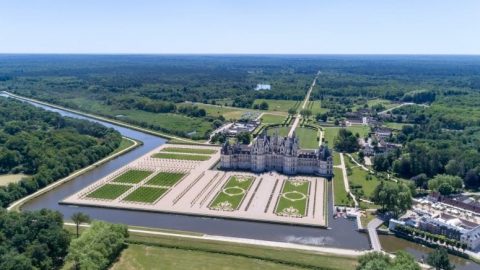A Step Back in Time

During the Term 1 holidays, History teachers, Ms Anna Curnow and Mr Chris Zuccala, led a group of Years 10 and 11 students on a discovery of French History dated back to before the French Revolution in 1789 to World War Two, which ended in 1945.
Over the course of two weeks, the group had the opportunity to visit several sites and landmarks of historical significance. These included the D-Day Landing Beaches of World War Two, the First World War Battlefields and several sites where important events unfolded before and during the French Revolution. I am proud to share some highlights of the tour as recounted by Ms Curnow and Mr Zuccala.
On their arrival in France, students were delighted by the romance of the turrets and grand spaces of the Château de Chambord. This castle, commenced in 1519 by a young Francois I, King of France, was imagined as an affirmation of royal power with its immense stone construction and is emblematic of the French Renaissance. The Château was not finished until the reign of Louis XIV and was lucky to survive the destruction of the French Revolution.
Students were also fortunate to visit the Château de Chenonceau, spanning the River Cher and probably the best known Château of the Loire Valley. In 1535, King Francis I incorporated it into the Crown Estate as part of a debt settlement. Later, King Henry II decided to offer it not to the Queen, but to his favourite, Diane de Poitiers, “in full right of ownership, seisin and possession, completely, peacefully and perpetually, to dispose of as her own and true patrimony.” This artificial exit of Chenonceau from Crown Lands meant that it was saved, two centuries later, from the French Revolution.
In Paris, students were able to visit the Louvre, the Palace of Versailles, the Invalides and participate in a walking tour of the French Revolution. It was fabulous for students to stand in the Hall of Mirrors at Versailles and picture the signing of the Treaty of Versailles in 1919, as well as imagine King Louis.
During their visit to the D-Day beaches, students toured the Omaha and Gold landing beaches, where they visited a D-Day museum and inspected the ruins of German bunkers. They also attended two war cemeteries, one of which was British and the other American.
On the First World War battlefields, the girls visited the war cemetery at Villers-Bretonneux where several Australian soldiers who fell in battle are buried. These war cemeteries gave a stark reminder of the tragic loss of life which occurred during war time. At Villers-Bretonneux, students also had the opportunity to tour the newly built Sir John Monash Centre, which highlighted the important role carried out by the Australian Military Forces during the First World War.
History Students Visit the Holocaust Museum
Closer to home, the Years 10 and 11 History Students visited the Holocaust Museum on Friday 17 May, where they were given insight into the atrocities of the Holocaust and gained greater understanding of how the Holocaust unfolded.
Starting with the Nazi Party led by Adolf Hitler stripping Jews of their rights and protection as citizens and persecuting them economically, socially and politically by forcing them into ghettos, which were scarce of food and medicine. Mass shootings of Jews followed this and the establishment of the extermination camps, such as Auschwitz. A confronting, but highly educational experience for the History students.
Australian History Competition
Finally, I would like to commend the Years 7 to 10 students who will be participating in the nationally recognised Australian History Competition on Wednesday 5 June. With over 30 St Catherine’s students choosing to compete, it certainly reflects the level of interest and passion students have in History. I wish them all the very best.


